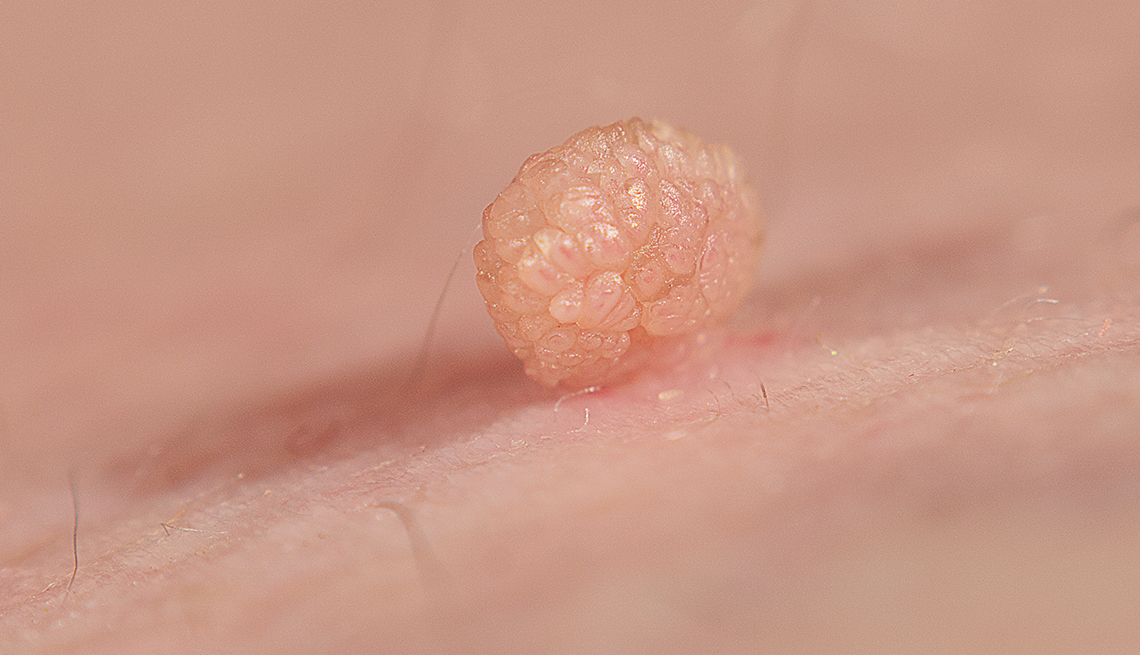Skin Tags: What They Are and When You Should Remove Them - AARP
En español
At some point, you might have lifted an arm or peered at your neck in the mirror and discovered a skin-colored growth that wasn't there before. What you found was most likely a skin tag, given that about half of us will have at least one of these harmless protuberances over the course of our lifetime. The older we get, the more of them seem to pop up.
Skin tags, or what your dermatologist calls acrochordons, are usually harmless and nothing to worry about. Yet there are some situations in which you'll want to consult with your doctor, especially if you're wondering whether to remove these growths or let them be. Read on for answers to some common questions about skin tags.
What are skin tags?
Skin tags are nothing more than outgrowths of regular skin attached to a thin stalk, or base. They're usually the same color as the rest of your skin, although sometimes they can be slightly darker.
Most skin tags are a couple of millimeters across — less than the width of a pencil eraser — but they can grow larger.
What causes skin tags?
The most likely culprit is friction. Skin tags often form in areas where skin rubs against skin or fabric, says Sara Lamb, M.D., assistant professor of dermatology at Johns Hopkins. So don't be surprised if you see them in places like your armpits, under your breasts, in the creases of your thighs or on the part of your neck that regularly brushes against your shirt collar or a necklace.
Obesity slightly increases your risk for skin tags, again because of that skin-on-skin friction. They're also more common in people with type 2 diabetes, which probably has more to do with the weight connection than the disease, Lamb says. Skin tags can actually be a sign of early diabetes — one of the reasons you should pay attention to them. Scientists think insulin resistance may be linked to skin tag growth.
Some families collect more of these growths than others. Scientists haven't yet discovered a "skin tag gene," but if a few of your close relatives have skin tags, genetically speaking they may be in your future, too.
The reason is probably that friction builds over the passing years, according to Lamb. Also with age comes a loss of skin elasticity. Sagging skin is more likely to rub than firm skin.
Are skin tags dangerous?
The sight of any new skin growth can send your mind spinning straight to the big C, but skin tags aren't cancer. In fact, they're usually harmless.
Can a skin tag turn into cancer?
"Technically, yes, because it's skin like any part of your body," says Lamb. She's seen one case of a skin tag turning into basal cell skin cancer. Still, it's extremely rare for that to happen.
The only real risk with a skin tag is that it might twist around on its stalk and cut off its own blood supply. Without blood, the skin tag will die, and it could become infected.
Skin tags that get caught in a necklace, shirt collar or piece of your hair can also be painful. That's often what prompts people to want them removed, says Susan Massick, M.D., a board-certified dermatologist at The Ohio State University Wexner Medical Center.
How can you tell whether it's something more serious?
What looks like a skin tag to the untrained eye might actually be a mole, which could be cancerous. Don't necessarily rely on your own detective work and assume that a growth is a skin tag. If you're unsure, get it checked out, Massick suggests. See your doctor or a dermatologist.
When should you remove a skin tag?
A skin tag that's infected or inflamed should come off, says Lamb. Otherwise, you don't need to remove it unless you don't like the way it looks or it's getting caught in your clothes or jewelry and irritating you. Keep in mind that if you do have a skin tag removed simply because of its appearance, your insurance company will likely consider the procedure cosmetic and won't cover the cost.
Can you remove skin tags yourself?
Massick says it's best to check with a doctor, but she has had some patients remove small skin tags themselves. You just need to be careful.
First, make sure your scissors are sterile. The ones you find lying at the bottom of your junk drawer could cause an infection. Either boil them or clean them with rubbing alcohol. The scissors also need to be small enough to reach the skin tag's base, and sharp. "If they're dull, you're not going to be able to cut through the skin," Massick says. Clean the skin tag area as well.
Prepare yourself for a bit of bleeding after you snip. Have some gauze ready to stop it.
Another home-removal technique is to tie off the skin tag with a piece of string or dental floss. If you want to try this, make sure you tie the string tightly around the base of the skin tag close to your skin. (It shouldn't be painful, Massick says. If it is painful, take the string off.) That will cut off the skin tag's blood supply. Leave the string in place. It can take a few days for a skin tag to die and fall off.
How do dermatologists remove skin tags?
For larger skin tags or any you're unsure about, see your dermatologist, Massick says. Your doctor can cut, freeze or burn off the growth. They can also biopsy the removed tissue to make sure it's benign (not cancerous).
The method your doctor uses to remove skin tags will depend on their size. "If there are a lot of little ones, we can quickly freeze them like we freeze warts," Lamb says. "If it's bigger ones, we'll snip them."
To freeze them off, also called cryosurgery, your doctor will spray liquid nitrogen onto each spot. The super-cold liquid creates little blisters. "As the blister falls off, the skin tag will fall off as well," says Massick. The process takes time. Expect to wait anywhere from a few days to two weeks for the skin tag to fall off. Cauterization involves a similar process, but it uses heat to burn off skin tags.
Another advantage to seeing a doctor is that it's less painful than the do-it-yourself method. An injection of lidocaine numbs the area around larger skin tags, so you won't feel anything during the procedure.
Can skin tags come back after you remove them?
A skin tag shouldn't grow back after an in-office procedure, but don't be surprised if you see a new one in the same area. "They tend to congregate in similar locations — skin folds, arms and neck, in between the thighs and under the breasts. So if you have one, you'll probably get more as time goes on," Massick says.
More on Skin Care
- Worst habits for your skin
- 11 ways to get healthier-looking skin fast
- Top skin-care problems for women over 50



Comments
Post a Comment